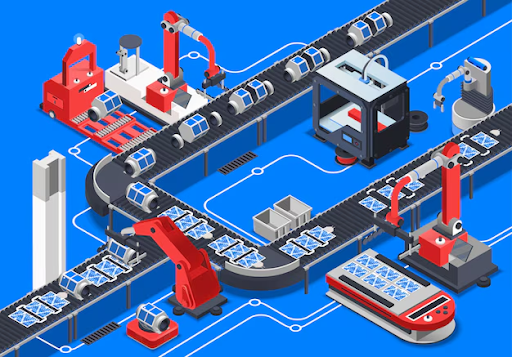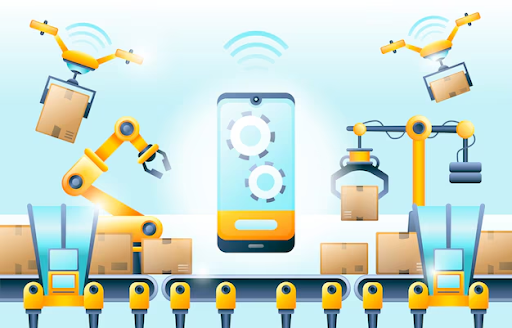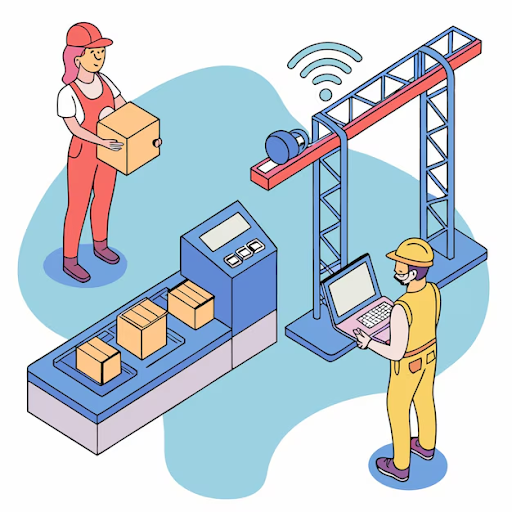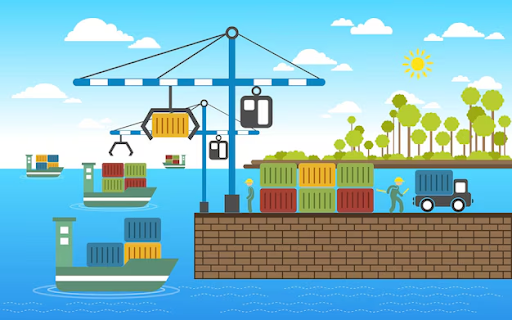Faced with increasing pressure from global supply chain disruptions and rising consumer demand, the transportation and logistics industry is on the brink of transformation. Port and terminal automation is gradually becoming a prominent trend in the modern logistics industry, helping to enhance operational efficiency, reduce costs, and optimize operational processes. With the development of technologies such as artificial intelligence (AI), the Internet of Things (IoT), and autonomous guided vehicles (AGV), ports and terminals around the world are gradually transitioning to smart, automated operational models. However, the implementation of automation also comes with its fair share of challenges.
How have these innovations impacted the industry, and what challenges and opportunities do they present for freight forwarding companies? Let's explore this together in this article.
1. What is terminal and port automation?

Automating terminals and ports involves using technology to automate various tasks and processes. Including container handling and stacking, gate operations, and cargo tracking. The digitization of the port aims to improve overall efficiency, safety, and productivity in the operations of the terminal and port.
Some examples of automated terminals:
The Qingdao New Qianwan Container Terminal (QQCTN) in China, when it began operations in May 2017, achieved the distinction of being the first terminal of its kind in Asia.
The Pasir Panjang Terminal of the Port of Singapore Authority has a high level of automation with an advanced terminal automation system. These examples highlight the global acceptance of port automation on major shipping routes.
2. The trend towards automation at ports and terminals

The increasing pressure of global trade and the constant fluctuations of supply chains are strongly driving the automation process at ports and terminals worldwide. The increasing demand for efficiency and productivity has compelled logistics companies to seek process optimization solutions. Automation is not just an option but also an urgent requirement to meet the enormous volume of goods and ensure timely delivery.
2.1 Meeting the demands of global trade
Global trade is expanding, leading to a surge in the volume of goods. Automated terminals and container ports, with the ability to operate 24/7 and optimize container handling, are considered solutions to the difficult bottlenecks currently faced in the supply chain.
Experts believe that automated terminal systems and processes can lead to more efficient use of resources such as terminal space and equipment. This is very important because the industry is increasing the number of larger ships and the pressure to transport goods quickly. By automating processes, the industry can handle the increasing demand of international trade more efficiently.
Terminal automation systems bridge the gap between Enterprise Resource Planning (ERP) systems and Supervisory Control and Data Acquisition (SCADA) systems, generating high ROI for companies storing large quantities of liquids.
2.2 Labor challenges at ports
Like many other industries, the maritime transport sector is facing a labor shortage and rising labor costs. The shortage of long-haul truck drivers caused by the pandemic has only exacerbated these issues, leading to significant congestion and delays. Introducing automation into ports requires less manual labor, providing a way to mitigate these challenges and maintain a steady flow of goods. Terminal automation software automates manual processes such as load authorization, product movement, and documentation, streamlining operations to increase productivity and efficiency.
2.3 Environmental concerns and automation
The maritime industry is facing increasing pressure to reduce carbon emissions. The adoption of automated electrical equipment contributes to this goal, as seen in their recognition as the "Greenest Seaport."
These technologies, along with optimized operations, contribute to reducing emissions and creating a more sustainable port ecosystem. The shift towards these environmentally friendly activities aligns with the global momentum towards sustainability in all sectors.
3. Benefits of port terminal automation

The integration of automation technologies such as automated stacking cranes (ASC), which often use lidar-based systems, is revolutionizing many aspects of port operations. This impacts both internal workflows and external supply chain interactions. Let's explore the benefits that container port automation is making a mark.
3.1 Enhancing efficiency and throughput
Fully automated ports promise faster and more efficient container handling, leading to quicker ship turnaround times and increased overall terminal throughput. Take the Port of Long Beach in the United States as an example, where not only has it won awards for sustainability but also witnessed record annual container throughput thanks to the implementation of automated solutions. The transition to smart digital ports has played a crucial role in achieving these impressive results.
The terminal automation systems are integrated with tank measurement systems to enhance efficiency and container throughput. This further reinforces the port's position as a leading international port. The port's ability to handle more containers in a shorter time demonstrates the practical benefits of implementing automation in a competitive global market.
3.2 Safety and security are improved.
Automated systems can inherently reduce the risk of human error, promoting safer working conditions in the often hazardous port environment. Technologies such as automated gate systems enhance security by streamlining access control and monitoring.
3.3 Data analysis and decision-making are optimized.
Automated systems generate vast amounts of data that can be analyzed to improve operational efficiency. This data-driven approach facilitates better planning, resource allocation, and predictive maintenance. By harnessing the power of data, port management authorities can make more informed decisions, optimize resource utilization, and minimize downtime.
3.4 Cost savings in operations
Although the initial investment cost for automation is quite high, in the long run, ports and terminals can significantly save on labor, energy, and equipment maintenance costs. For example, a port using automated cranes can reduce labor costs by up to 50% compared to manual operation.
4. Challenges and considerations in port automation

Although the benefits are clear, the implementation of automated ports and terminals also faces many challenges.
4.1 High initial investment costs
The shift to automation requires a significant capital investment in automation equipment. Ports embarking on this transformation process must carefully consider the financial aspects, potential return on investment, and long-term economic impact on port operators. Port operators face challenges in realizing the benefits of automation, such as high initial capital costs and the mismatch between expectations and actual outcomes in terms of cost reduction and productivity improvement.
4.2 Disruption of the workforce and the need for retraining
The ability to replace jobs due to automation is a real concern. The government and port authorities need to address these workforce concerns. Investing in retraining and upskilling programs for employees will be key.
A great example is training traditional crane operators to become technicians for smart port automation systems and equipment. This will ensure that the skilled workforce is ready to operate and manage these advanced systems.
It will also help workers who are worried about losing their livelihoods to transition more easily. Addressing these concerns proactively is essential for a smooth transition to an automated port environment.
4.3 Data security vulnerabilities
As the reliance on connected digital systems in automated ports and container terminals increases, their susceptibility to cyberattacks also rises. A recent survey highlighted that despite confidence in cybersecurity preparedness, over 70% of stakeholders in the maritime industry had experienced a successful or attempted cyber attack in the past year.
The survey also indicated that ransomware is a significant threat, with experts believing that actual incidents are reported much less frequently. Strong cybersecurity measures must be integrated and prioritized to protect sensitive data and ensure operational continuity.
4.4 Balancing automation with operational flexibility
While automation thrives in structured environments, ports often encounter unpredictable situations, such as unexpected weather events, equipment malfunctions, and changes in arrival times. Over-reliance on automation can sometimes hinder the agility needed in such situations.
Ports must strike a balance, combining automation with human expertise to ensure operational resilience and quick adaptation to dynamic conditions. This approach combines the efficiency of automation with the adaptability of human intervention, creating a robust and more responsive port ecosystem.
5. Long-term vision: From automated ports to integrated supply chains
The ultimate goal is to move beyond isolated automation towards a future where ports are seamlessly integrated with the entire supply chain, unlocking new levels of efficiency and visibility.
5.1 Seamless connectivity and data sharing
Imagine a future where ports not only operate as isolated hubs but also integrate seamlessly with the entire supply chain. This level of seamless connectivity, supported by terminal automation solutions, will be driven by real-time data sharing, from cargo information to vessel schedules, creating unprecedented transparency, predictability, and collaborative planning across the entire system.
We have witnessed how seamlessly integrated systems, such as chatbot software, can transform the flow of information and communication in other industries. The transportation and logistics industry is poised for a similar revolution, driven by data sharing and collaboration.
5.2 The rise of AI and predictive logistics
Beyond pure automation tasks, imagine leveraging AI and machine learning to analyze the massive data generated across the entire supply chain. With such advancements, this will enable the proactive identification of potential bottlenecks and the optimization of processes.
5.3 Applying modular transport solutions
Emerging concepts, such as modular aviation, demonstrate that adaptability and rapid response will be key for future transport networks. The success of automated ships, even at their current stage of development, indicates a clear direction for the future of maritime transport.The success of autonomous ships, even at the current stage of development, shows a clear direction for the future of maritime transport.
6. Conclusion
As technology continues to develop, the industry can expect to see increasingly smarter port solutions, prioritizing flexibility and efficiency to respond to changing global trade patterns. Automated ports and terminals represent a significant step towards a more efficient, resilient, and sustainable future for global trade. Freight forwarding companies must understand these changing dynamics because early adopters of automation technology are gaining a competitive advantage.
In the future, with the continuous development of technology, automated ports will become smarter, more connected, and more environmentally friendly. Automation is not merely about replacing humans with machines; it is a revolution in the way we transport goods, contributing to the creation of a more connected and sustainable world.